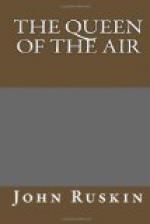173. It means that the Nemean Lion is the first great adversary of life, whatever that may be—to Hercules, or to any of us, then or now. The first monster we have to strangle, or be destroyed by, fighting in the dark, and with none to help us, only Athena standing by to encourage with her smile. Every man’s Nemean Lion lies in wait for him somewhere. The slothful man says, There is a lion in the path. He says well. The quiet unslothful man says the same, and knows it too. But they differ in their further reading of the text. The slothful man says, I shall be slain, and the unslothful, it shall be. It is the first ugly and strong enemy that rises against us, all future victory depending on victory over that. Kill it; and through all the rest of your life, what was once dreadful is your armor, and you are clothed with that conquest for every other, and helmed with its crest of fortitude for evermore.
Alas, we have most of us to walk bare-headed; but that is the meaning of the story of Nemea,—worth laying to heart and thinking of sometimes, when you see a dish garnished with parsley, which was the crown at the Nemean games.
174. How far, then, have we got in our list of the merits of Greek art now?
Sound knowledge.
Simple aims.
Mastered craft.
Vivid invention.
Strong common
sense.
And eternally
true and wise meaning.
Are these not enough? Here is one more, then, which will find favor, I should think, with the British Lion. Greek art is never frightened at anything; it is always cool.
175. It differs essentially from all other art, past or present, in this incapability of being frightened. Half the power and imagination of every other school depend on a certain feverish terror mingling with their sense of beauty,—the feeling that a child has in a dark room, or a sick person in seeing ugly dreams. But the Greeks never have ugly dreams. They cannot draw anything ugly when they




